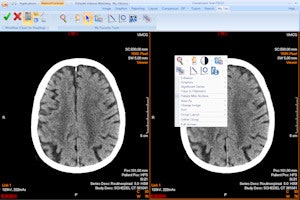
Frustrated by the complexity of your PACS workstation software and not sure how to best customize it to meet your needs? Adaptive customization support may be the answer, according to researchers from the University of Groningen (UMCG) in the Netherlands.
After radiologists were provided with individualized help for customizing their PACS software, the Dutch researchers found that the adaptive customization support helped radiologists utilize the software's customization features more effectively. The participating radiologists added more functions to the custom area of the interface, removed more infrequently used custom functions, and used the custom area of the screen more often after receiving the support.
"This means that the support not only increased the quantity of customization but the quality," said Wiard Jorritsma, who is currently pursuing a doctorate on human-computer interaction in medical imaging. Subjectively, users also found the support to be valuable.
Jorritsma, who expects to complete his thesis by December 2015, presented the findings during a scientific session at ECR 2014 in Vienna.
Growing PACS complexity
The number and complexity of functions included in PACS software is very high and continues to increase. In addition, different radiologists may interact differently with the software based on their respective needs, Jorritsma said.
"This makes it quite difficult to create a PACS interface that suits each radiologist," he said.
Most PACS software includes an adaptable interface that allows radiologists to customize several aspects of the display. However, many users may not customize effectively or even customize at all, he said.
Because adaptive customization support (i.e., helping users to customize their interface) has been shown to offer potential for increasing customization effectiveness in other domains, the research team sought to evaluate the usefulness of such support for PACS user interfaces.
Specifically, they wanted to determine if customization support increases the effectiveness with which radiologists employ the PACS software's customization capabilities and if customization support increases the efficiency with which users interact with the PACS. They also were interested to learn if the radiologists perceived the customization support to be useful.
They recruited 12 radiologists for a 12-week study. All radiologists had their actions logged when using the standard version of the PACS software. After six weeks, six radiologists received customization support based on the logging data.
Adaptive support
Adaptive customization support was provided in the form of user-specific customization suggestions that were generated based on a log of functions that had been used by the specific radiologist. It also provided radiologists with insights into their own function usage in order to suggest what customizations to perform, he said.
','dvPres', 'clsTopBtn', 'true' );" >

Click image to enlarge.
Graphical user interface of the PACS (Carestream Health's Vue PACS v11.3) software used in the study. The toolbar at the top consists of multiple tabs, each with a different set of functions. One of these tabs, labeled 'My Tab' is customizable. Pop-up menu shown over the right CT image appears when the right mouse button is clicked. The top region of this menu that contains the icons can also be customized. Image courtesy of Wiard Jorritsma.
Because the customization support component wasn't able to be integrated into the actual PACS interface (Carestream Health's Vue PACS v11.3), this information was presented in a mock-up setting by a human experimenter, he said.
Radiologist participants were given a list and statistics of the workstation functions they used, including data on frequency of use and percentage of total function use. Based on the analysis, the users were then given suggestions to add functions to the custom interface for those that constituted in aggregate more than 80% of the functions they used. They were also encouraged to drop infrequently used functions from the custom interface, according to Jorritsma.
Perceived efficiency gains
After the support was provided to the six radiologists, the researchers continued to log workstation actions over the remaining six weeks of the study for all 12 radiologists. The team then assessed customization frequency, custom region usage, efficiency (defined as average time needed to review a radiographic study), and subjective responses from the users.
The median number of added custom functions was approximately zero for both groups over the first six weeks of the study, but increased dramatically for users who received support. The same pattern was observed for the number of functions removed from the custom region. The number of functions used from the custom region also increased in the group that had been given customization support, he said.
No statistical difference was found in terms of efficiency between the two groups, but this was likely because the performance measure used in the study wasn't sensitive enough, Jorritsma said.
In terms of subjective responses, however, all participants who received the customization support found it valuable and perceived that it increased their efficiency, according to the researchers.
"Adaptive customization support is a useful addition to an adaptable PACS interface," Jorritsma said.



















